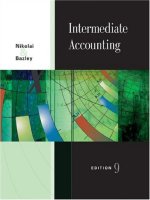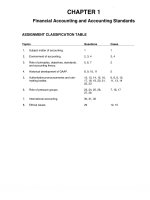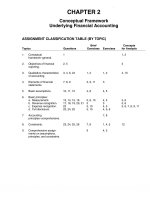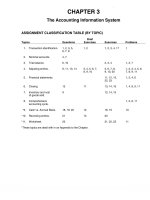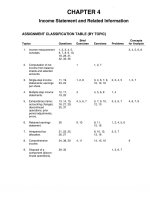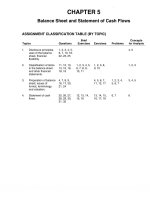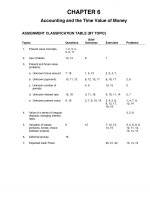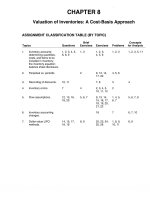Solution manual intermediate accounting 13e kieso ch23
Bạn đang xem bản rút gọn của tài liệu. Xem và tải ngay bản đầy đủ của tài liệu tại đây (410.76 KB, 74 trang )
To download more slides, ebook, solutions and test bank, visit
CHAPTER 23
Statement of Cash Flows
ASSIGNMENT CLASSIFICATION TABLE (BY TOPIC)
Topics
Questions
Brief
Exercises
Exercises
Concepts
Problems for Analysis
1.
Format, objectives
purpose, and source
of statement.
1, 2, 7,
8, 12
2.
Classifying investing,
financing, and operating
activities.
3, 4, 5, 6,
16, 17, 19,
24
1, 2, 3,
6, 7, 8,
12
1, 2, 10
1, 3, 4, 5
3.
Direct vs. indirect
methods of preparing
operating activities.
9, 20
4, 5, 9,
10, 11
3, 4
5
4.
Statement of cash flows—
direct method.
11, 13, 14
8
3, 5, 7, 9,
12, 13
3, 4, 6
5.
Statement of cash flows—
indirect method.
10, 13,
15, 16
8
4, 6, 8, 11,
14, 15, 16,
17, 18, 20
1, 2, 4, 5,
6, 7, 8, 9
2
6.
Preparing schedule
of noncash investing
and financing activities.
18
12
5, 7, 8, 9
5
7.
Worksheet adjustments.
21
13
Copyright © 2010 John Wiley & Sons, Inc.
1, 2, 5, 6
19, 21
Kieso, Intermediate Accounting, 13/e, Solutions Manual
(For Instructor Use Only)
23-1
To download more slides, ebook, solutions and test bank, visit
ASSIGNMENT CLASSIFICATION TABLE (BY LEARNING OBJECTIVE)
Learning Objectives
Brief
Exercises
Exercises
Problems
1.
Describe the purpose of the statement
of cash flows.
2.
Identify the major classifications
of cash flows.
3
1, 2, 10, 16
3.
Differentiate between net income and net
cash flows from operating activities.
4, 5, 9, 10, 11
2, 3, 4, 5, 6,
7, 8, 16
6, 7
4.
Contrast the direct and indirect methods
of calculating net cash flow from operating
activities.
4, 5, 6, 7, 9
3, 4, 5,
6, 7, 8
6, 7
5.
Determine net cash flows from investing
and financing activities.
1, 2
16
6.
Prepare a statement of cash flows.
8
9, 11, 12, 13,
14, 15, 17, 18
7.
Identify sources of information
for a statement of cash flows.
8.
Discuss special problems in preparing
a statement of cash flows.
12
10, 18
9.
Explain the use of a worksheet in
preparing a statement of cash flows.
13
19, 20, 21
23-2
Copyright © 2010 John Wiley & Sons, Inc.
1, 2, 3, 4, 5,
6, 7, 8, 9
1, 2, 4,
5, 8, 9
Kieso, Intermediate Accounting, 13/e, Solutions Manual
1, 2, 4, 5,
6, 7, 8, 9
(For Instructor Use Only)
To download more slides, ebook, solutions and test bank, visit
ASSIGNMENT CHARACTERISTICS TABLE
Level of
Difficulty
Time
(minutes)
Simple
Moderate
Simple
10–15
20–30
15–25
Simple
Simple
Simple
Simple
Moderate
20–30
20–30
15–20
15–20
20–30
Moderate
Moderate
Moderate
Moderate
Moderate
Moderate
Moderate
Moderate
20–30
25–35
30–35
20–30
30–40
30–40
25–35
30–40
Moderate
Moderate
Moderate
Moderate
Moderate
30–40
25–30
20–25
20–25
45–55
Moderate
Moderate
Complex
Moderate
Complex
Moderate
40–45
50–60
50–60
45–60
50–65
40–50
Moderate
30–40
P23-8
P23-9
SCF—indirect method.
SCF—indirect method.
SCF—direct method.
SCF—direct method.
SCF—indirect method.
SCF—indirect method, and net cash flow from operating
activities, direct method.
SCF—direct and indirect methods from comparative
financial statements.
SCF—direct and indirect methods.
Indirect SCF.
Moderate
Moderate
30–40
30–40
CA23-1
CA23-2
CA23-3
CA23-4
CA23-5
CA23-6
Analysis of improper SCF.
SCF theory and analysis of improper SCF.
SCF theory and analysis of transactions.
Analysis of transactions’ effect on SCF.
Purpose and elements of SCF.
Cash flow reporting, ethics.
Moderate
Moderate
Moderate
Moderate
Complex
Moderate
30–35
30–35
30–35
20–30
30–40
20–30
Item
Description
E23-1
E23-2
E23-3
Classification of transactions.
Statement presentation of transactions—indirect method.
Preparation of operating activities section—indirect method,
periodic inventory.
Preparation of operating activities section—direct method.
Preparation of operating activities section—direct method.
Preparation of operating activities section—indirect method.
Computation of operating activities—direct method.
Schedule of net cash flow from operating activities—
indirect method.
SCF—direct method.
Classification of transactions.
SCF—indirect method.
SCF—direct method.
SCF—direct method.
SCF—indirect method.
SCF—indirect method.
Cash provided by operating, investing, and financing
activities.
SCF—indirect method and balance sheet.
Partial SCF—indirect method.
Worksheet analysis of selected accounts.
Worksheet analysis of selected transactions.
Worksheet preparation.
E23-4
E23-5
E23-6
E23-7
E23-8
E23-9
E23-10
E23-11
E23-12
E23-13
E23-14
E23-15
E23-16
E23-17
E23-18
E23-19
E23-20
E23-21
P23-1
P23-2
P23-3
P23-4
P23-5
P23-6
P23-7
Copyright © 2010 John Wiley & Sons, Inc.
Kieso, Intermediate Accounting, 13/e, Solutions Manual
(For Instructor Use Only)
23-3
To download more slides, ebook, solutions and test bank, visit
SOLUTIONS TO CODIFICATION EXERCISES
CE23-1
Master Glossary
(a)
Cash equivalents are short-term, highly liquid investments that have both of the following
characteristics:
1.
2.
Readily convertible to known amounts of cash
So near their maturity that they present insignificant risk of changes in value because of
changes in interest rates.
Generally, only investments with original maturities of three months or less qualify under that
definition. Original maturity means original maturity to the entity holding the investment. For example,
both a three-month U.S. Treasury bill and a three-year Treasury note purchased three months
from maturity qualify as cash equivalents. However, a Treasury note purchased three years ago
does not become a cash equivalent when its remaining maturity is three months. Examples of
items commonly considered to be cash equivalents are Treasury bills, commercial paper, money
market funds, and federal funds sold (for an entity with banking operations).
(b)
Financing activities include obtaining resources from owners and providing them with a return on,
and a return of, their investment; receiving restricted resources that by donor stipulation must be
used for long-term purposes; borrowing money and repaying amounts borrowed, or otherwise
settling the obligation; and obtaining and paying for other resources obtained from creditors on
long-term credit.
(c)
Investing activities include making and collecting loans and acquiring and disposing of debt or
equity instruments and property, plant, and equipment and other productive assets, that is,
assets held for or used in the production of goods or services by the entity (other than materials
that are part of the entity’s inventory). Investing activities exclude acquiring and disposing of
certain loans or other debt or equity instruments that are acquired specifically for resale, as
discussed in paragraphs 230-10-45-12 and 230-10-45-21.
(d)
Operating activities include all transactions and other events that are not defined as investing or
financing activities (see paragraphs 230-10-45-12 through 45-15). Operating activities generally
involve producing and delivering goods and providing services. Cash flows from operating
activities are generally the cash effects of transactions and other events that enter into the
determination of net income.
CE23-2
According to FASB ASC 230-10-45-14 (Statement of Cash Flow—Other Presentation Matters—Cash
Flows from Financing Activities):
All of the following are cash inflows from financing activities:
(a)
Proceeds from issuing equity instruments.
(b)
Proceeds from issuing bonds, mortgages, notes, and from other short- or long-term borrowing.
23-4
Copyright © 2010 John Wiley & Sons, Inc.
Kieso, Intermediate Accounting, 13/e, Solutions Manual
(For Instructor Use Only)
To download more slides, ebook, solutions and test bank, visit
CE23-2 (Continued)
(c)
Receipts from contributions and investment income that by donor stipulation are restricted for the
purposes of acquiring, constructing, or improving property, plant, equipment, or other long-lived
assets or establishing or increasing a permanent endowment or term endowment.
(d)
Proceeds received from derivative instruments that include financing elements at inception,
whether the proceeds were received at inception or over the term of the derivative instrument,
other than a financing element inherently included in an at-the-market derivative instrument with
no prepayments.
(e)
Cash retained as a result of the tax deductibility of increases in the value of equity instruments
issued under share-based payment arrangements that are not included in the cost of goods or
services that is recognizable for financial reporting purposes. For this purpose, excess tax
benefits shall be determined on an individual award (or portion thereof) basis.
CE23-3
According to FASB ASC 230-10-45-11 (Statement of Cash Flows—Other Presentation Matters—Cash
Flows from Investing Activities):
Cash flows from purchases, sales, and maturities of available-for-sale securities shall be classified as
cash flows from investing activities and reported gross in the statement of cash flows.
CE23-4
According to FASB ASC 230-10-50-3 (Statement of Cash Flows—Disclosure—Noncash Investing and
Financing Activities):
Information about all investing and financing activities of an entity during a period that affect recognized
assets or liabilities but that do not result in cash receipts or cash payments in the period shall be
disclosed. Those disclosures may be either narrative or summarized in a schedule, and they shall
clearly relate the cash and noncash aspects of transactions involving similar items.
Copyright © 2010 John Wiley & Sons, Inc.
Kieso, Intermediate Accounting, 13/e, Solutions Manual
(For Instructor Use Only)
23-5
To download more slides, ebook, solutions and test bank, visit
ANSWERS TO QUESTIONS
1. The main purpose of the statement of cash flows is to show the change in cash of a company from
one period to the next. The statement of cash flows provides information about a company’s
operating, financing, and investing activities. More precisely, it provides information about the
company’s cash inflows and outflows for the period.
2. Some uses of this statement are:
Assessing future cash flows: Income data when augmented with current cash flow data provide a
better basis for assessing future cash flows.
Assessing quality of income: Some believe that cash flow information is more reliable than
income information because income involves a number of assumptions, estimates and valuations.
Assessing operating capability: Whether an enterprise is able to maintain its operating capability,
provide for future growth, and distribute dividends to the owners depends on whether adequate
cash is being or will be generated.
Assessing financial flexibility and liquidity: Cash flow data indicate whether a company should
be able to survive adverse operating problems and whether a company might have difficulty in
meeting obligations as they become due, paying dividends, or meeting other recurring costs.
Providing information on financing and investing activities: Cash flows are classified by their
effect on balance sheet items; investing activities affect assets while financing activities affect
liabilities and stockholders’ equity.
3. Investing activities generally involve noncurrent assets and include (1) lending money and collecting
on those loans and (2) acquiring and disposing of investments and productive long-lived assets.
Financing activities, on the other hand, involve liability and owners’ equity items and include
(1) obtaining cash from creditors and repaying the amounts borrowed and (2) obtaining capital
from owners and providing them with a return on their investment. Operating activities include all
transactions and events that are not investing and financing activities. Operating activities involve
the cash effects of transactions that enter into the determination of net income.
4. Examples of sources of cash in a statement of cash flows include cash from operating activities,
issuance of debt, issuance of capital stock, sale of investments, and the sale of property, plant,
and equipment. Examples of uses of cash include cash used in operating activities, payment of
cash dividends, redemption of debt, purchase of investments, redemption of capital stock, and the
purchase of property, plant, and equipment.
5. Preparing the statement of cash flows involves three major steps:
(1) Determine the change in cash. This is simply the difference between the beginning and ending
cash balances.
(2) Determine the net cash flow from operating activities. This involves analyzing the current year’s
income statement, comparative balance sheets and selected transaction data.
(3) Determine cash flows from investing and financing activities. All other changes in balance
sheet accounts are analyzed to determine their effect on cash.
6. Purchase of land—investing;
Payment of dividends—financing;
Cash sales—operating;
Purchase of treasury stock—financing.
7. Comparative balance sheets, a current income statement, and certain transaction data all provide
information necessary for preparation of the statement of cash flows. Comparative balance sheets
indicate how assets, liabilities, and equities have changed during the period. A current income
statement provides information about the amount of cash provided from operating activities. Certain
transactions provide additional detailed information needed to determine whether cash was provided
or used during the period.
23-6
Copyright © 2010 John Wiley & Sons, Inc.
Kieso, Intermediate Accounting, 13/e, Solutions Manual
(For Instructor Use Only)
To download more slides, ebook, solutions and test bank, visit
Questions Chapter 23 (Continued)
8. It is necessary to convert accrual-based net income to a cash basis because net income includes
items that do not provide or use cash. An example would be an increase in accounts receivable.
If accounts receivable increased during the period, revenues reported on the accrual basis would
be higher than the actual cash revenues received. Thus, accrual basis net income must be adjusted
to reflect the net cash flow from operating activities.
9. Net cash flow from operating activities under the direct method is the difference between cash
revenues and cash expenses. The direct method adjusts the revenues and expenses directly to
reflect the cash basis. This results in cash net income, which is equal to “net cash flow from
operating activities.”
The indirect method involves adjusting accrual net income. This is done by starting with accrual
net income and adding or subtracting noncash items included in net income. Examples of adjustments include depreciation and other noncash expenses and changes in the balances of current
asset and current liability accounts from one period to the next.
10. Net cash flow from operating activities is $3,820,000. Using the indirect method, the solution is:
Net income................................................................................................
$3,500,000
Adjustments to reconcile net income to net cash
provided by operating activities:
Depreciation expense ......................................................................
$ 520,000
Accounts receivable increase.........................................................
(500,000)
Accounts payable increase .............................................................
300,000
320,000
Net cash provided by operating activities ....................................
$3,820,000
11. Accrual basis sales .........................................................................
Less: Increase in accounts receivable ......................................
Less: Writeoff of accounts receivable........................................
Cash sales .......................................................................................
$100,000
30,000
70,000
2,000
$ 68,000
12. A number of factors could have caused an increase in cash despite the net loss. These are: (1) high
cash revenues relative to low cash expenses, (2) sales of property, plant, and equipment, (3) sales
of investments, and (4) issuance of debt or capital stock.
13. Declared dividends .........................................................................
Add: Dividends payable (beginning of year) ............................
Deduct: Dividends payable (end of year)..................................
Cash paid in dividends during the year ......................................
$260,000
85,000
345,000
90,000
$255,000
14. To determine cash payments to suppliers, it is first necessary to find purchases for the year. To
find purchases, cost of goods sold is adjusted for the change in inventory (increased when inventory increases or decreased when inventory decreases). After purchases are computed, cash
payments to suppliers are determined by adjusting purchases for the change in accounts payable.
An increase (decrease) in accounts payable is deducted from (added to) purchases to determine
cash payments to suppliers.
15. Cash flows from operating activities
Net income.......................................................................................
Adjustments to reconcile net income to net cash
provided by operating activities:
Depreciation expense...........................................................
Amortization of patent...........................................................
Loss on sale of plant assets ................................................
Net cash provided by operating activities ..................................
Copyright © 2010 John Wiley & Sons, Inc.
Kieso, Intermediate Accounting, 13/e, Solutions Manual
$320,000
$124,000
40,000
21,000
(For Instructor Use Only)
185,000
$505,000
23-7
To download more slides, ebook, solutions and test bank, visit
Questions Chapter 23 (Continued)
16. (a) Cash flows from operating activities
Net income .............................................................................................
Adjustments to reconcile net income to net
cash provided by operating activities:
Loss on sale of plant assets
[($18,000 ÷ 10) x 31/2 ] – $4,000 ............................................
Cash flows from investing activities
Sale of plant assets ..............................................................................
(b)
(c)
XXXX
Cash flows from financing activities
Issuance of common stock .................................................................
$
2,300
$
4,000
$410,000
No effect on cash; not shown in the statement of cash flows or in any related schedules
or notes.
Note to instructor: The change in net accounts receivable is an adjustment to net income
under the indirect method.
(d)
Cash flows from operating activities
Net loss...................................................................................................
Adjustments to reconcile net loss to net cash
provided by operating activities:
Depreciation expense ..........................................................................
Gain on sale of available-for-sale securities....................................
Cash flows from investing activities
Sale of available-for-sale securities ..................................................
17. (a) Operating activity.
(b) Financing activity.
(c) Investing activity.
(d) Operating activity.
(e) Significant noncash investing
and financing activities.
(f) Financing activity.
$(50,000)
$22,000
(9,000)
$ 38,000
(g) Operating activity.
(h) Financing activity.
(i) Significant noncash investing
and financing activities.
(j) Financing activity.
(k) Investing activity.
(l) Operating activity.
18. Examples of noncash transactions are: (1) issuance of stock for noncash assets, (2) issuance of stock
to liquidate debt, (3) issuance of bonds or notes for noncash assets, and (4) noncash exchanges of
property, plant, and equipment.
19. Cash flows from operating activities
Net income ......................................................................................................
Adjustments to reconcile net income to net cash
provided by operating activities:
Gain on redemption of bonds payable..............................................
Cash flows from financing activities
Redemption of bonds payable ....................................................................
XXXX
$
(120,000)
$(1,880,000)
20. Arguments for the indirect or reconciliation method are:
(a) By providing a reconciliation between net income and cash provided by operations, the
differences are highlighted.
(b) The direct method is nothing more than a cash basis income statement which will confuse
and create uncertainty for financial statement users who are familiar with the accrual-based
income statements.
23-8
Copyright © 2010 John Wiley & Sons, Inc.
Kieso, Intermediate Accounting, 13/e, Solutions Manual
(For Instructor Use Only)
To download more slides, ebook, solutions and test bank, visit
Questions Chapter 23 (Continued)
(c)
There is some question as to whether the direct method is cost/benefit-justified as this
method would probably lead to additional preparation cost because the financial records are
not maintained on a cash basis.
21. A worksheet is desirable because it allows the orderly accumulation and classification of data that
will appear on the statement of cash flows. It is an optional but efficient device that aids in the
preparation of the statement of cash flows.
22. IAS 7, “Cash Flow Statements,” provides the overall iGAAP requirements for cash flow information.
23. As is U.S. GAAP, the statement of cash flows is a required statement for iGAAP. In addition, the content
and presentation of an iGAAP balance sheet is similar to one used for U.S. GAAP. However, the
disclosure requirements related to the statement of cash flows are more extensive under U.S. GAAP.
Other similarities include: (1) Companies preparing financial statements under iGAAP must
prepare a statement of cash flows as an integral part; (2) Both iGAAP and U.S. GAAP require that
the statement of cash flows should have three major sections—operating, investing and
financing—along with changes in cash and cash equivalents; (3) Similar to U.S. GAAP, the cash
flow statement can be prepared using either the indirect or direct method under iGAAP. In both
U.S. and international settings, companies choose for the most part to use the indirect method for
reporting net cash flows from operating activities.
Notable differences are (1) iGAAP encourages companies to disclose the aggregate amount of
cash flows that are attributable to the increase in operating capacity separately from those cash
flows that are required to maintain operating capacity; (2) The definition of cash equivalents used
in iGAAP is similar to that used in U.S. GAAP. A major difference is that in certain situations bank
overdrafts are considered part of cash and cash equivalents under iGAAP (which is not the case in
U.S. GAAP). Under U.S. GAAP, bank overdrafts are classified as financing activities; (3) iGAAP
requires that noncash investing and financing activities be excluded from the statement of cash
flows. Instead, these noncash activities should be reported elsewhere. This requirement is interpreted to mean that noncash investing and financing activities should be disclosed in the notes to
the financial statements instead of in the financial statements. Under U.S. GAAP, companies may
present this information in the cash flow statement.
24. The following table relates to the classification of interest, dividends, and taxes and indicates
relative degree of choice inherent under iGAAP. As some note, this increased degree of choice can
lead to expanded disclosure under iGAAP.
Item
Interest paid
Interest received
Dividends paid
Dividends received
Taxes paid
iGAAP
Operating or financing
Operating or investing
Operating or financing
Operating or investing
Operating—unless specific identification
with financing or investing
U.S. GAAP
Operating
Operating
Financing
Operating
Operating
25. Presently, the FASB and the IASB are involved in a joint project on the presentation and
organization of information in the financial statements. The FASB favors presentation of operating
cash flows using the direct method only. However, the majority of IASB members express a
preference for not requiring use of the direct method of reporting operating cash flows. So the two
Boards will have to resolve their differences in this area in order to issue a converged standard for
the statement of cash flows.
Copyright © 2010 John Wiley & Sons, Inc.
Kieso, Intermediate Accounting, 13/e, Solutions Manual
(For Instructor Use Only)
23-9
To download more slides, ebook, solutions and test bank, visit
SOLUTIONS TO BRIEF EXERCISES
BRIEF EXERCISE 23-1
Cash flow from investing activities
Sale of land...................................................................................
Purchase of equipment ............................................................
Purchase of available-for-sale securities...........................
Net cash used by investing activities..................................
$ 180,000
(415,000)
(59,000)
$(294,000)
BRIEF EXERCISE 23-2
Cash flow from financing activities
Issuance of common stock.....................................................
Issuance of bonds payable.....................................................
Payment of dividends ...............................................................
Purchase of treasury stock.....................................................
Net cash provided by financing activities..........................
$ 250,000
510,000
(350,000)
(46,000)
$ 364,000
BRIEF EXERCISE 23-3
(a)
(b)
(c)
(d)
(e)
(f)
23-10
P-I
A
R-F
A
R-I
R-I, D
(g)
(h)
(i)
(j)
(k)
(l)
P-F
D
P-I
A
D
R-F
Copyright © 2010 John Wiley & Sons, Inc.
(m)
(n)
(o)
(p)
(q)
(r)
N
D
R-F
P-F
R-I, A
P-F
Kieso, Intermediate Accounting, 13/e, Solutions Manual
(For Instructor Use Only)
To download more slides, ebook, solutions and test bank, visit
BRIEF EXERCISE 23-4
Cash flows from operating activities
Cash received from customers
($200,000 – $12,000) .................................................
Cash payments
To suppliers
($120,000 + $11,000 – $13,000) .................... $118,000
For operating expenses
($50,000 – $21,000) ..........................................
29,000
Net cash provided by operating activities............
$188,000
147,000
$ 41,000
BRIEF EXERCISE 23-5
Cash flows from operating activities
Net income ......................................................................
Adjustments to reconcile net income
to net cash provided by operating
activities:
Depreciation expense ........................................
Increase in accounts payable..........................
Increase in accounts receivable.....................
Increase in inventory..........................................
Net cash provided by operating activities............
$30,000
$21,000
13,000
(12,000)
(11,000)
11,000
$41,000
BRIEF EXERCISE 23-6
Sales ............................................................................................
Add: Decrease in accounts receivable
($72,000 – $54,000)......................................................
Cash receipts from customers............................................
$420,000
18,000
$438,000
BRIEF EXERCISE 23-7
Cost of goods sold..................................................................
Add: Increase in inventory ($113,000 – $95,000) .........
Purchases ..................................................................................
Deduct: Increase in accounts payable
($69,000 – $61,000)................................................
Cash payments to suppliers................................................
Copyright © 2010 John Wiley & Sons, Inc.
Kieso, Intermediate Accounting, 13/e, Solutions Manual
$500,000
18,000
518,000
8,000
$510,000
(For Instructor Use Only)
23-11
To download more slides, ebook, solutions and test bank, visit
BRIEF EXERCISE 23-8
Net cash provided by operating activities.............................
Net cash used by investing activities .....................................
Net cash provided by financing activities .............................
Net increase in cash .....................................................................
Cash, 1/1/10......................................................................................
Cash, 12/31/10 .................................................................................
$531,000
(963,000)
585,000
153,000
333,000
$486,000
BRIEF EXERCISE 23-9
(a)
(b)
a
Cash flows from operating activities
Cash received from customers........................................
Cash paid for expenses ($60,000 – $1,840) .................
Net cash provided by operating activities.........
Cash flows from operating activities
Net income..............................................................................
Increase in net accounts receivable
($26,960a – $18,800b) .......................................................
Net cash provided by operating activities.........
($29,000 – $2,040)
$90,000
58,160
$31,840
$40,000
(8,160)
$31,840
b
($20,000 – $1,200)
BRIEF EXERCISE 23-10
Cash flows from operating activities
Net income.............................................................................
$50,000
Adjustments to reconcile net income to net cash
provided by operating activities
Depreciation expense ........................................................ 17,000)
Increase in accounts payable ......................................... 12,300)
Increase in accounts receivable .................................... (11,000)
Increase in inventory ......................................................... (7,400) 10,900
Net cash provided by operating activities.........
$60,900
23-12
Copyright © 2010 John Wiley & Sons, Inc.
Kieso, Intermediate Accounting, 13/e, Solutions Manual
(For Instructor Use Only)
To download more slides, ebook, solutions and test bank, visit
BRIEF EXERCISE 23-11
Cash flows from operating activities
Net loss ..............................................................................
Adjustments to reconcile net income (loss)
to net cash provided by operating activities
Depreciation expense ..........................................
Increase in accounts receivable.......................
Net cash provided by operating activities..............
($70,000)
81,000)
(8,100)
72,900
$ 2,900
BRIEF EXERCISE 23-12
(a)
Land.....................................................................................
Common Stock .....................................................
Paid-in Capital in Excess of Par......................
(b)
No effect
(c)
Noncash Investing and Financing Activities
Purchase of land through issuance of
common stock ...................................................
40,000
10,000
30,000
$40,000
BRIEF EXERCISE 23-13
(a)
(b)
(c)
(d)
Operating—Net Income .................................................
Retained Earnings ................................................
317,000
Retained Earnings ...........................................................
Financing—Cash Dividends..............................
120,000
Equipment ..........................................................................
Investing—Purchase of Equipment ................
114,000
Investing—Sale of Equipment.....................................
Accumulated Depreciation—Equipment..................
Equipment ...............................................................
Operating—Gain on Sale of Equipment ........
10,000
32,000
317,000
120,000
114,000
40,000
2,000*
*$10,000 – ($40,000 – $32,000)
Copyright © 2010 John Wiley & Sons, Inc.
Kieso, Intermediate Accounting, 13/e, Solutions Manual
(For Instructor Use Only)
23-13
To download more slides, ebook, solutions and test bank, visit
SOLUTIONS TO EXERCISES
EXERCISE 23-1 (10–15 minutes)
(a)
(b)
(c)
(d)
(e)
(f)
(g)
(h)
(i)
(j)
(k)
(l)
Operating—add to net income.
Financing activity.
Investing activity.
Operating—add to net income.
Significant noncash investing and financing activity.
Financing activity.
Operating—add to net income.
Financing activity.
Significant noncash investing and financing activity.
Financing activity.
Operating—deduct from net income.
Investing activity.
EXERCISE 23-2 (20–30 minutes)
(a)
Plant assets (cost) .......................................................................
Accumulated depreciation ([$25,000 ÷ 10] X 6)..................
Book value at date of sale .........................................................
Sale proceeds................................................................................
Loss on sale...................................................................................
$25,000)
15,000)
10,000)
(5,300)
$ 4,700)
The loss on sale of plant assets is reported in the operating activities
section of the statement of cash flows. It is added to net income to
arrive at net cash provided by operating activities.
The sale proceeds of $5,300 are reported in the investing activities
section of the statement of cash flows as follows:
Sale of plant assets ....................................................................
(b)
Shown in the financing activities section of a statement of cash
flows as follows:
Sale of common stock................................................................
23-14
$5,300
Copyright © 2010 John Wiley & Sons, Inc.
Kieso, Intermediate Accounting, 13/e, Solutions Manual
$330,000
(For Instructor Use Only)
To download more slides, ebook, solutions and test bank, visit
EXERCISE 23-2 (Continued)
(c)
The writeoff of the uncollectible accounts receivable of $27,000 is not
reported on the statement of cash flows. The writeoff reduces the
Allowance for Doubtful Accounts balance and the Accounts Receivable
balance. It does not affect cash flows.
Note to instructor: The change in net accounts receivable is sometimes used to compute an adjustment to net income under the indirect
method.
(d)
The net loss of $50,000 should be reported in the operating activities
section of the statement of cash flows. Depreciation of $22,000 is
reported in the operating activities section of the statement of cash
flows. The gain on sale of land also appears in the operating activities
section of the statement of cash flows. The proceeds from the sale of
land of $39,000 are reported in the investing activities section of the
statement of cash flows. These four items might be reported as follows:
Cash flows from operating activities
Net loss........................................................................
Adjustments to reconcile net income
to net cash used in operating activities*:
Depreciation ..................................................... 22,000
Gain on sale of land ....................................... (9,000)
$(50,000)
*Either net cash used or provided depending upon other adjustments.
Given only the adjustments in (d), the “net cash used” should be
employed.
Cash flows from investing activities
Sale of land ................................................................
$39,000
(e)
The purchase of the U.S. Treasury bill is not reported in the statement
of cash flows. This instrument is considered a cash equivalent and
therefore cash and cash equivalents have not changed as a result of
this transaction.
(f)
Patent amortization of $20,000 is reported in the operating activities
section of the statement of cash flows. It is added to net income in
arriving at net cash provided by operating activities.
Copyright © 2010 John Wiley & Sons, Inc.
Kieso, Intermediate Accounting, 13/e, Solutions Manual
(For Instructor Use Only)
23-15
To download more slides, ebook, solutions and test bank, visit
EXERCISE 23-2 (Continued)
(g)
The exchange of common stock for an investment in Plumlee is
reported as a “noncash investing and financing activity.” It is shown
as follows:
Noncash investing and financing activities
Purchase of investment by issuance
of common stock ........................................... $900,000
(h)
The purchase of treasury stock is reported as a cash payment in the
financing activities section of the statement of cash flows.
EXERCISE 23-3 (15–25 minutes)
RODRIQUEZ COMPANY
Partial Statement of Cash Flows
For the Year Ended December 31, 2010
Cash flows from operating activities
Net income .........................................................................
Adjustments to reconcile net income
to net cash provided by operating activities:
Depreciation expense............................................
Decrease in accounts receivable.......................
Decrease in inventory............................................
Increase in prepaid expenses.............................
Decrease in accounts payable ...........................
Decrease in accrued expenses payable..........
Net cash provided by operating activities......
23-16
Copyright © 2010 John Wiley & Sons, Inc.
$1,050,000
$ 60,000
310,000
300,000
(170,000)
(275,000)
(120,000)
Kieso, Intermediate Accounting, 13/e, Solutions Manual
105,000
$1,155,000
(For Instructor Use Only)
To download more slides, ebook, solutions and test bank, visit
EXERCISE 23-4 (20–30 minutes)
RODRIQUEZ COMPANY
Partial Statement of Cash Flows
For the Year Ended December 31, 2010
Cash flows from operating activities
Cash receipts from customers .................
$7,210,000 (a)
Cash payments ..............................................
To suppliers ............................................ $4,675,000 (b)
For operating expenses...................... 1,380,000 (c) 6,055,000
Net cash provided by operating
activities.......................................................
$1,155,000
Computations:
(a) Cash receipts from customers
Sales..........................................................
Add: Decrease in accounts
receivable ....................................
Cash receipts from customers .........
(b)
(c)
$6,900,000
310,000
$7,210,000
Cash payments to suppliers
Cost of goods sold ...............................
Deduct: Decrease in inventories......
Purchases................................................
Add: Decrease in accounts
payable .........................................
Cash payments to suppliers .............
Cash payments for operating
expenses
Operating expenses, exclusive
of depreciation ..................................
Add: Increase in prepaid
expenses ......................................
Add: Decrease in accrued
Add:
expenses payable.................
Cash payments for operating
expenses .............................................
$4,700,000
300,000
4,400,000
275,000
$4,675,000
$1,090,000*
$170,000
120,000
290,000
$1,380,000
*$450,000 + ($700,000 – $60,000)
Copyright © 2010 John Wiley & Sons, Inc.
Kieso, Intermediate Accounting, 13/e, Solutions Manual
(For Instructor Use Only)
23-17
To download more slides, ebook, solutions and test bank, visit
EXERCISE 23-5 (20–30 minutes)
NORMAN COMPANY
Partial Statement of Cash Flows
For the Year Ended December 31, 2010
Cash flows from operating activities
Cash receipts from customers...........
Cash payments........................................
For operating expenses ...............
For income taxes ............................
Net cash provided by operating
activities .................................................
(a)
(b)
(c)
23-18
$862,000 (a)
$609,000 (b)
44,500 (c)
Computation of cash receipts from customers:
Revenue from fees....................................................
Add: Decrease in accounts receivable
Ad
($59,000 – $37,000)........................................
Cash receipts from customers .............................
Computation of cash payments:
Operating expenses per income statement .....
Deduct: Increase in accounts payable
Deduct ($46,000 – $31,000)..................................
Cash payments for operating expenses............
Income tax expense per income statement......
Add: Decrease in income taxes payable
Add ($8,500 – $4,000) ............................................
Cash payments for income taxes ........................
Copyright © 2010 John Wiley & Sons, Inc.
Kieso, Intermediate Accounting, 13/e, Solutions Manual
653,500
$208,500
$840,000
22,000
$862,000
$624,000
15,000
$609,000
$ 40,000
4,500
$ 44,500
(For Instructor Use Only)
To download more slides, ebook, solutions and test bank, visit
EXERCISE 23-6 (15–20 minutes)
NORMAN COMPANY
Partial Statement of Cash Flows
For the Year Ended December 31, 2010
Cash flows from operating activities
Net income .........................................................................
Adjustments to reconcile net income
to net cash provided by operating activities:
Depreciation expense..............................................
Loss on sale of equipment ....................................
Decrease in accounts receivable ........................
Increase in accounts payable...............................
Decrease in income taxes payable .....................
Net cash provided by operating activities...............
$90,000
$60,000
26,000
22,000
15,000
(4,500)
118,500
$208,500
EXERCISE 23-7 (15–20 minutes)
Situation A: Cash flows from operating activities
Cash receipts from customers
($200,000 – $71,000) .................................................. $129,000
Cash payments for operating expenses
($110,000 – $39,000) ..................................................
71,000
Net cash provided by operating activities.............. $ 58,000
Situation B: (a) Computation of cash payments to suppliers
Cost of goods sold ............................................ $310,000
Plus: Increase in inventory.............................
21,000
Decrease in accounts payable...........
17,000
Cash payments to suppliers ....................................... $348,000
(b) Computation of cash payments for
operating expenses
Operating expenses .......................................... $230,000
Deduct: Decrease in prepaid expenses .....
8,000
Increase in accrued expenses
payable.............................................
11,000
Cash payments for operating expenses..... $211,000
Copyright © 2010 John Wiley & Sons, Inc.
Kieso, Intermediate Accounting, 13/e, Solutions Manual
(For Instructor Use Only)
23-19
To download more slides, ebook, solutions and test bank, visit
EXERCISE 23-8 (20–30 minutes)
Cash flows from operating activities
Net income
Adjustments to reconcile net income
to net cash provided by operating
activities:
Depreciation expense........................................
Gain on sale of investment
[($200 – $165) X 100]....................................
Decrease in accounts receivable...................
Income from equity method investment
($27,000 X .30)................................................
Dividends from equity investment
($2,000 X .30).................................................
Net cash provided by operating activities ...........
$145,000
$39,000
(3,500)
12,000
(8,100)
600
40,000
$185,000
Other comments:
No. 1 is shown as a cash inflow from the issuance of treasury stock and
cash outflow for the purchase of treasury stock, both financing activities.
No. 2 is shown as a cash inflow from investing activities of $20,000 and the
gain of $3,500 is deducted from net income in the operating activities section.
No. 3 is a noncash expense (Bad Debt Expense) in the income statement.
Bad debt expense is not handled separately when using the indirect method.
It is part of the change in net accounts receivable.
No. 4 is a significant noncash investing and financing activity.
No. 6 is an increase in the investment account related to net income which
does not increase cash flow. The net income amount must be deducted
from net cash flow from operating activities.
No. 7 (dividends received) is added to net income. Another alternative is
to net the Company’s pro-rata share of the dividend against the income
from equity method investment amount reported in the cash flows from
operating activities.
No. 8 is not shown on a statement of cash flows.
23-20
Copyright © 2010 John Wiley & Sons, Inc.
Kieso, Intermediate Accounting, 13/e, Solutions Manual
(For Instructor Use Only)
To download more slides, ebook, solutions and test bank, visit
EXERCISE 23-9 (20–30 minutes)
1.
2.
3.
4.
5.
Sales.............................................................................................
Deduct: Increase in accounts receivable,
net of write-offs
[$33,000 – ($30,000 – $3,800)].............................
Cash collected from customers..........................................
Cost of goods sold ..................................................................
Deduct: Decrease in inventory ($47,000 – $31,000).....
Purchases...................................................................................
Deduct: Increase in accounts payable
($25,000 – $17,000).................................................
Cash payments to suppliers ................................................
Interest expense.......................................................................
Deduct: Decrease in unamortized bond discount
($5,000 – $4,500) .....................................................
Cash paid for interest.............................................................
Income tax expense ................................................................
Add: Decrease in income taxes payable
($29,100 – $21,000) ......................................................
Deduct: Increase in deferred income taxes
($5,300 – $4,600) .....................................................
Cash paid for income taxes..................................................
Selling expenses......................................................................
Deduct: Depreciation ($3,000* X 1/3) ................................ 1,000
Bad debts expense ................................................ 5,000
Cash paid for selling expenses...........................................
$538,800
6,800
$532,000
$250,000
16,000
234,000
8,000
$226,000
$
4,300
$
500
3,800
$ 20,400
8,100
700
$ 27,800
$141,500
6,000
$135,500
*($16,500 – $13,500)
Copyright © 2010 John Wiley & Sons, Inc.
Kieso, Intermediate Accounting, 13/e, Solutions Manual
(For Instructor Use Only)
23-21
To download more slides, ebook, solutions and test bank, visit
EXERCISE 23-10 (25–35 minutes)
1.
The solution can be determined through use of a T-account for property, plant, and equipment.
Property, Plant & Equipment
12/31/09
Equipment from exchange of B/P
Payments for purchase of PP&E
247,000
25,000
?
12/31/10
277,000
45,000 Equipment sold
Payments = $277,000 + $45,000 – $247,000 – $25,000
= $50,000
GAAP states that investing activities include the acquisition and
disposition of long-term productive assets. Accordingly, the purchase
of property, plant, and equipment is an investing activity. Note that
the acquisition of property, plant, and equipment in exchange for bonds
payable would be disclosed as a noncash investing and financing
activity.
2.
The solution can be determined through use of a T-account for accumulated depreciation.
Accumulated Depreciation
167,000
12/31/09
38,000
Equipment sold
Depreciation expense
?
178,000
12/31/10
Accumulated depreciation on equipment sold = $167,000 + $38,000 –
$178,000 = $27,000
The entry to reflect the sale of equipment is:
Cash (proceeds from sale of equipment)
($45,000 + $14,500 – $27,000)
Accumulated Depreciation
Property, Plant, and Equipment
Gain on Sale of Equipment
23-22
Copyright © 2010 John Wiley & Sons, Inc.
32,500
27,000
45,000
14,500
Kieso, Intermediate Accounting, 13/e, Solutions Manual
(given)
(given)
(For Instructor Use Only)
To download more slides, ebook, solutions and test bank, visit
EXERCISE 23-10 (Continued)
The proceeds from the sale of equipment of $32,500 are considered
an investing activity. Investing activities include the acquisition and
disposition of long-term productive assets.
3.
The cash dividends paid can be determined by analyzing T-accounts
for Retained Earnings and Dividends Payable.
Retained Earnings
Dividends declared
?
91,000
31,000
104,000
12/31/09
Net income
12/31/10
Dividends declared = $91,000 + $31,000 – $104,000
= $18,000
Dividends Payable
5,000
18,000
Cash dividends paid
12/31/09
Dividends declared
?
8,000
12/31/10
Cash dividends paid = $5,000 + $18,000 – $8,000
= $15,000
Financing activities include all cash flows involving liabilities and stockholders’ equity other than operating items. Payment of cash dividends
is thus a financing activity.
4.
The redemption of bonds payable amount is determined by setting up
a T-account.
Bonds Payable
Redemption of B/P
46,000
25,000
12/31/09
Issuance of B/P for PP&E
49,000
12/31/10
?
The problem states that there was no amortization of bond premium
or discount; thus, the redemption of bonds payable is the only change
not accounted for.
Copyright © 2010 John Wiley & Sons, Inc.
Kieso, Intermediate Accounting, 13/e, Solutions Manual
(For Instructor Use Only)
23-23
To download more slides, ebook, solutions and test bank, visit
EXERCISE 23-10 (Continued)
Redemption of bonds payable = $46,000 + $25,000 – $49,000
= $22,000
Financing activities include all cash flows involving liabilities and
stockholders’ equity other than operating items. Therefore, redemption
of bonds payable is considered a financing activity.
23-24
Copyright © 2010 John Wiley & Sons, Inc.
Kieso, Intermediate Accounting, 13/e, Solutions Manual
(For Instructor Use Only)
To download more slides, ebook, solutions and test bank, visit
EXERCISE 23-11 (30–35 minutes)
FAIRCHILD COMPANY
Statement of Cash Flows
For the Year Ended December 31, 2010
(Indirect Method)
Cash flows from operating activities
Net income ...................................................................................
$ 810
Adjustments to reconcile net income to net cash
provided by operating activities:
Depreciation expense ($1,200 – $1,170).................... $ 30
Gain on sale of investments..........................................
(80)
Decrease in inventory...................................................... 300
Increase in accounts payable ....................................... 400
Increase in receivables ................................................... (450)
Decrease in accrued liabilities .....................................
(50)
150
Net cash provided by operating activities .........................
960
Cash flows from investing activities
Sale of held-to-maturity investments
[($1,470 – $1,300) + $80] ......................................................
Purchase of plant assets [($1,900 – $1,700) – $70].........
Net cash provided by investing activities..........................
Cash flows from financing activities
Issuance of capital stock [($1,900 – $1,700) – $70] ..........
Retirement of bonds payable...................................................
Payment of cash dividends ......................................................
Net cash used by financing activities...................................
250
(130)
120
130
(250)
(260)
(380)
Net increase in cash ..............................................................................
Cash, January 1, 2010...........................................................................
Cash, December 31, 2010 ....................................................................
700
1,100
$1,800
Noncash investing and financing activities
Issuance of common stock for plant assets.......................
$
Copyright © 2010 John Wiley & Sons, Inc.
Kieso, Intermediate Accounting, 13/e, Solutions Manual
(For Instructor Use Only)
70
23-25

